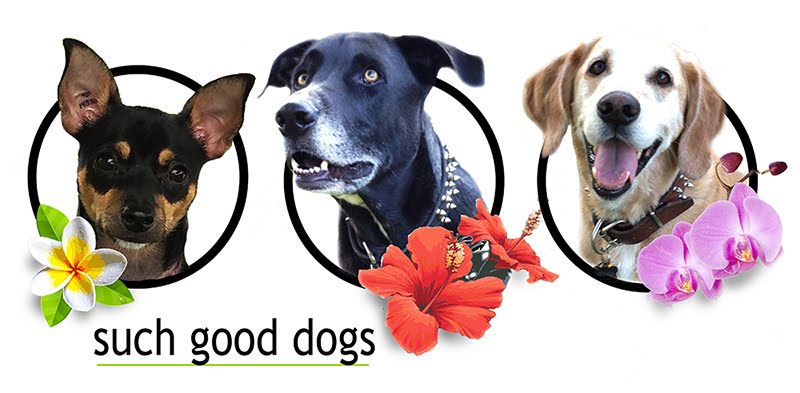 |
| Devo (L) & Caravaggio (R) helping Emmy (middle) experience a balanced pack walk. |
Training:
If you are having any problems properly training your current dog, please do NOT adopt another dog. Many times I hear people talk about how they want to get a second dog for their current dog to play with. This is fine unless you are unable to control the dog you currently have, or unable to properly exercise him. DO NOT adopt a second dog just to give your current dog something to do. If you cannot control one dog, you most certainly will not be able to control a second or third. Instead, focus on training and exercise with the dog you have.
Compatibility:
Just because you may like the personality of a second dog, does not necessarily mean your current dog will. When adding a new dog member to your family, you must first consider your current dog. Is your current dog friendly with other dogs? Does your current dog enjoy playing with other dogs? Even if your current dog is usually friendly, we must still be sure that the dogs will get along.
Most rescues and shelters (including Maui Humane Society) will allow you to bring your current dog to the shelter for a "meet and greet" with a new potential dog. This is an excellent idea and I recommend you do this before bringing home a new potential dog. Allow your current dog to evaluate the possible new dog as well. Do they seem to get along? Does it look like they could become friends?
If your current dog or the potential new dog seems exceptionally uncomfortable or aggressive, this may not be the correct match. Staff and volunteers may be able to help assist you in helping make this decision.
Everyone involved, including all current family members, the current family dog, and the new potential dog should feel comfortable.
Energy:
Be aware of your current dog's energy level. Is your dog low, medium, high, or very high energy? If you have a current dog that is high or very high energy, it would be best to adopt a second dog that is similar. If you have a dog who is low energy, he will most be able to get along with another dog with low or medium energy. Just like humans, dogs get along better with others who have the same interests and energy levels. One person who is a couch potato will not likely hang out with someone who hikes 5 miles every day. Energy is important. Be aware of it. Also remember to be aware of your own energy when looking at new potential adoptable dogs. Remain calm and observe a potential new dog's energy and temperament before adoption.
Gender:
Although it is not something usually considered by most people, gender can be important. I recommend adopting opposite sexes when their are two dogs within one family. Some dogs have more issues or potential issues with dog's of the same sex. Adopting dogs of opposite sexes eliminates many potential problems or competition.
Complimentary:
The best thing to do is to find a dog that compliments your current dog. For example if your current dog is a little bit shy, adopt a dog that is more calm and outgoing. If your current dog is sometimes reactive, adopt a second dog that is more calm and relaxed. If your current dog loves playing with dogs his size or smaller, adopt a dog that fits into that restriction. Additional members to the family should always compliment the current members of the family.
Bringing your second dog Home:
After your walk (at least 20 minutes, more if possible), keep your newly adopted dog on-leash when entering the house. Start the new dog off with an on-leash tour of the house, only entering a new room or space when the dog is calm. Doing this will reinforce to the new dog that you are the leader in this house and allow your current dog to relax because he sees you are in control of the new family member.
Monitor your dogs:
Be sure to closely monitor your dogs over the first few weeks to be sure everyone is continuing to get along well. Use a crate or baby gates to separate the dogs when they can not be supervised.
ALWAYS supervise feeding time and when giving any bones or treats to the dogs. Food can sometimes cause altercations between pets and supervision is important. Also be sure to monitor play time with both dogs. It is your job as the leader to set and enforce rules. You must monitor your dogs to be able to enforce these rules.
Other helpful Such Good Dog's blogs on this subject:
Proper Leadership for your Dog
Trainer Tips: A Schedule Matters.
Trainer Tips: What do dogs really want to do?
Trainer Tips Video: Proper Dog Socialization.
Pack Walk.
Other helpful articles:
How to Successfully Introduce a Second Dog Into Your Family by the Barking Lot.
A new member of the Pack by Cesar's Way.
















